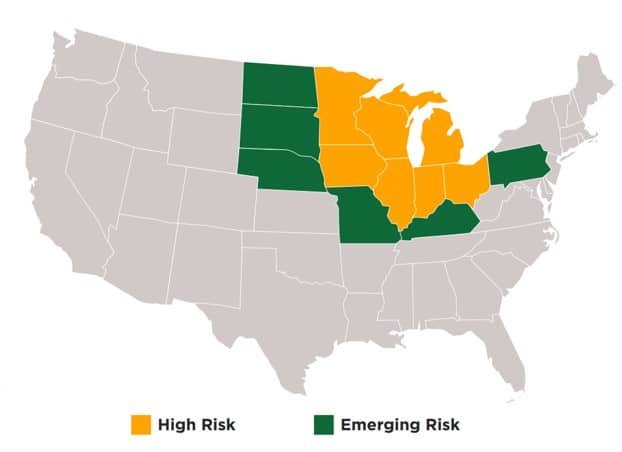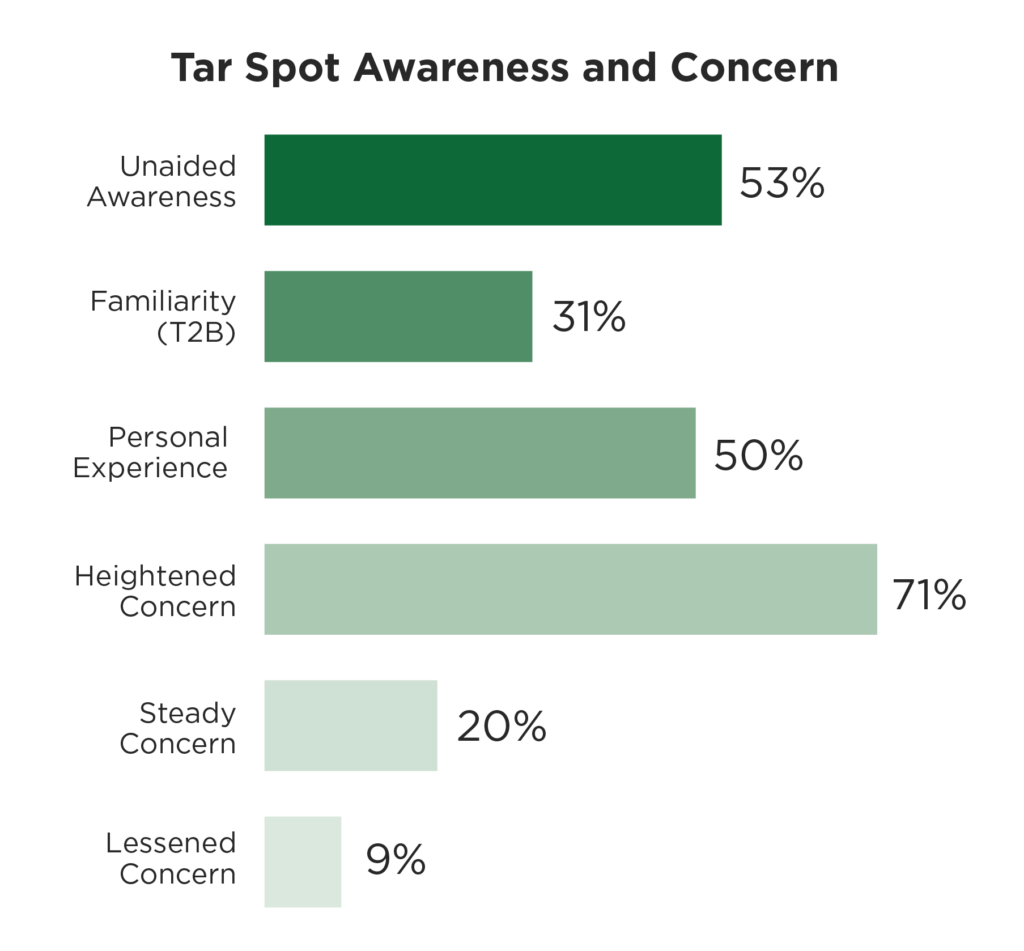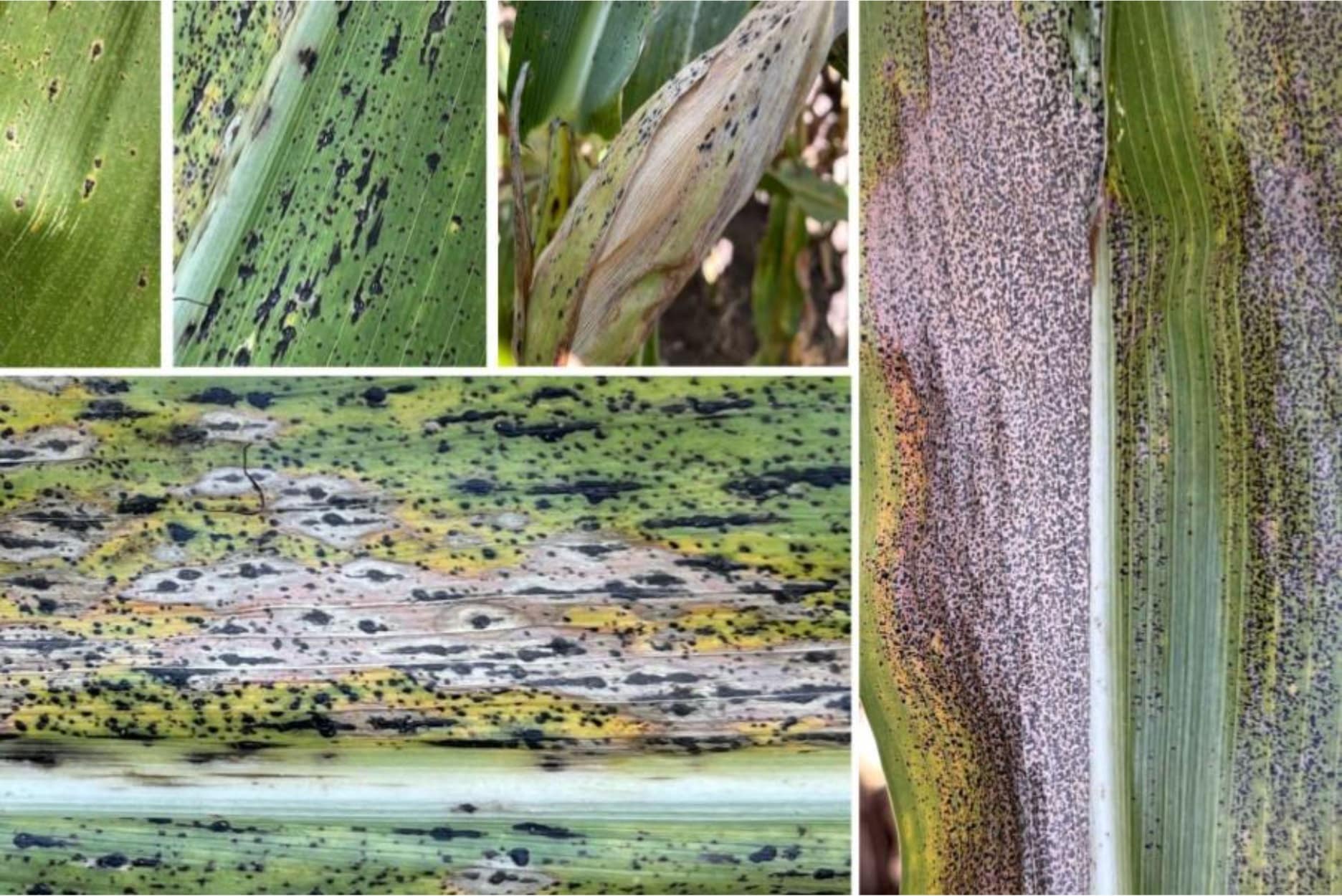Tar spot continues its march across the Midwest, with the telltale black specks putting more and more farmers on high alert. A new survey1 confirms tar spot has their full attention.
Over half of the nearly 400 farmers surveyed this fall cited tar spot when asked about diseases that may impact corn in their area, with one-third of the respondents naming tar spot first. Commissioned by AgReliant Genetics and conducted by Kynetec, survey findings were unveiled at AgReliant Genetics’ premiere Tar Spot Summit, an event that brought corn disease thought leaders together to share the latest in tar spot research and best management strategies.
Farmers’ tar spot concern eclipses worry about other diseases like northern corn leaf blight, southern rust, and Goss’s wilt, especially in states where tar spot is prevalent like Minnesota, Iowa, Wisconsin, Illinois, Michigan, Indiana and Ohio. Fifty-six percent of the farmers in these high-risk states are very or extremely concerned about the disease, distantly followed by northern corn leaf blight at 28%. While concern about tar spot is high, survey results indicate farmers lack clear direction on how to manage the disease.

“AgReliant Genetics is dedicated to bringing tools and information farmers need to manage diseases like tar spot,” says Christy Toedebusch, vice president of product management, marketing and digital at AgReliant Genetics. “We are sharing these survey results to help the industry gain a better understanding of farmers’ pain points when it comes to tar spot,” she says, adding that AgReliant’s agronomists are well versed in tar spot and helping farmers mitigate disease losses.
Dryness limited tar spot’s yield impact in 2022, but farmers remain anxious
Despite a relatively dry growing season in 2022 that limited tar spot impact, 71% of the farmers surveyed expressed heightened concern about the disease, primarily due to its rapid spread. When asked for additional comments, one respondent said, “Tar spot has been found within 20 miles of our farm, and we know the disease can be catastrophic.” Another commented that tar spot “has recently appeared in our area and had tremendous negative yield effect.”
The survey found half of the respondents had detected tar spot on their land at least once, with 90% of those hit by tar spot experiencing yield loss. The late arrival of the disease limited its impact on yields in 2022. However, the mean percentage of acres impacted across years of grower experience was high at 40%, signaling the potential for a major outbreak if the 2023 growing season is wetter.
The survey also showed tar spot affects profitability because farmers spend extra to ward off the disease, including applying fungicides, processing residue and otherwise managing the disease, even in years where weather is not right for tar spot.

Knowledge gap on tar spot management
While farmer awareness and concern about tar spot is high, the survey also revealed uncertainty about the disease mechanism and how to manage it. A third of the respondents had a good understanding of tar spot’s yield impact. However, only 16% said they understand how it overwinters, 17% understand how it spreads or under what conditions, 13% understand hybrid tolerance or tolerance ratings, and 17% understand fungicide efficacy.
One farmer’s comment in the survey about managing the disease demonstrates that uncertainty: “We had a major outbreak in 2021. In 2022, we applied fungicide, but there was practically no incidence of this disease in our area. Now we are unsure if it’s necessary to spray.”
Tolerant hybrids an important tool for fighting tar spot
Most farmers plan to use a combination of strategies to fight tar spot. The most common tactics for combatting tar spot are rotating crops (60% of farmers surveyed), scouting fields (48%) and planting hybrids with high tar spot tolerance scores (47%). Only 6% plan to do nothing to manage the disease.
Of note, 71% of farmers plan to plant hybrids with high tar spot tolerance scores in 2023, a 24-point increase over the percentage currently using tolerant hybrids. The increase speaks to the rapid spread of what can be a hard-hitting disease. Not surprisingly, the intention to plant tolerant hybrids is even higher for high-risk areas already dealing with tar spot. But even in emerging-threat states like the Dakotas, Nebraska, Missouri, Kentucky and Pennsylvania, 61% of farmers plan to purchase tar spot-tolerant hybrids.
Farmer awareness of tar spot tolerance in hybrids is high at 85%, but as few as one in three know about their seed brand’s tar spot tolerance offerings, according to the survey. Even so, 55% of farmers surveyed agreed that diversifying genetics helps mitigate risk.
“Genetic diversity provides critical protection against the weather and disease threats, tar spot included,” says Mike Kavanaugh, director of product development at AgReliant Genetics. “When you plant a diverse array of hybrids that may respond differently to different weather or disease challenges, you spread your risk.”
“Tar spot is an opportunistic disease that attacks weaker plants, which is why it’s so important to make diverse genetics a part of any tar spot management strategy,” Kavanaugh concludes.
Reference:
- Bellinger, M. and Clyne, D. AgReliant Genetics Tar Spot Study. Kynetec. Nov. 10, 2022.











